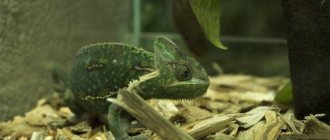If a beginner starts reading reviews from experienced chinchilla owners on the Internet, he will come across many conflicting opinions. The appearance of a chinchilla in your home can not only bring joy, but also create a lot of inconvenience. This article will help you figure out whether it is worth getting a chinchilla and will answer many questions that concern any breeder: how to care for the animal, whether the purchase will be useful for the child, what is the life expectancy of chinchillas, at what age can you take a rodent home, how to choose the right pet. It also contains a description of the animal and an interesting video with chinchillas.
Chinchilla as a pet
Description, behavior, character
Outwardly, chinchillas are very cute and attractive animals, so lovers of exotic pets buy them, not paying attention to the fact that this is a wild animal.
You can watch the chinchilla's antics for hours
Breeders are also attracted by the agility and jumping ability of nimble rodents. Although chinchillas do not like to be handled, it is a pleasure to watch them from the outside, which is why videos featuring chinchillas are very popular on the Internet. If you equip the cage with special ladders and shelves, you can create an attraction not only for your pet, but for the entire household.
You should not let the animal run around the room if the walking area is not prepared in advance.
The sneaky animal is in danger everywhere. He can easily jump onto the windowsill and get into any crack.
Chinchillas often show their character, making the owner touch. Chinchillas can demonstrate cunning, arrogance, greed and other traits. Animals are also very shy, so there is no need to impose your company on them. It is better to accustom the animal to your presence gradually.
On average, a chinchilla lives at home for 20 years. If you create good conditions for the animal, avoid hypothermia and overheating, provide proper care and a balanced diet, then its lifespan can be extended to 25 years.
Chinchilla care
Caring for a chinchilla will not take much time, but the breeder should know in advance how to care for the animal, here are a few rules:
- Update the contents of the drinking bowl daily.
- Refill the feeder 2 times a day.
- The food must be granulated. Be sure to give hay, carrots, dried apples and tree branches. It is forbidden to give sugar-containing and fresh foods.
- Ensure constant supervision by a veterinarian and carry out disease prevention. If a chinchilla gets sick, it is very difficult to cure it.
- The animal needs to have its teeth ground down; it is recommended to place a mineral stone in the cage.
- Chinchillas should not be bathed in water; a bathtub with volcanic sand must be installed in the pet’s home for bathing.
- When soiled, the litter needs to be changed; general cleaning is recommended weekly.
- It is better to place the cage with the animal away from radiators, sources of drafts and noise.
Character
By nature, chinchillas are very affectionate and tame; they almost never bite. The animal can bite only in a state of severe fright. All chinchillas are different, some like to be petted and others not so much, and these character traits need to be respected. What chinchillas do not tolerate is violence. In order to achieve mutual understanding with the animal, you need to show patience and persistence, and respect the peculiarities of its character and behavior.
After purchasing a chinchilla, you need to leave it alone for about a week and let it get used to its new place. Then, unpersistently, you need to extend your hand to her with a treat. If the chinchilla wants, she will come up, take the treat and climb into your arms. If not, you need to continue taming it day after day until the animal gets used to you.
A chinchilla may become offended if you leave it alone for a long time or simply do not pay attention to it. She won't want to play with you and won't even take treats from your hands.
Chinchillas are very good at manipulating their owners. They know exactly what needs to be done to get what they want: they will sit in a corner and look at you with sad eyes, or they will jump on their hind legs to get a treat or go for a walk around the room.
Should I get a chinchilla?
Before deciding whether to get a chinchilla as a pet, you need to not only familiarize yourself with the animal’s vital functions, but also answer a number of questions.
How will my child react?
According to reviews from experienced chinchilla breeders, a child can harm the animal. Children love to cuddle pets, stroke them, and grab them by the tail. It is not advisable to do all these manipulations with a chinchilla. In addition to the stress that the animal experiences when it is grabbed, it can suffer mechanical damage. There are cases where children accidentally broke the legs of rodents. The animal will also shed fur from the place where it was grabbed, so frequent contact between the chinchilla and the child will not benefit either the pet or the baby. After all, an animal may react inadequately to harassment and, in turn, also scare small household members.
If your child just likes to watch animals, and you are sure that he will not disturb the peace of the rodent, then the child is not an obstacle to getting a chinchilla.
Will other pets be a problem?
Stories about the friendly union of various animals may make you want to make friends with a chinchilla with a cat, dog, rodents and other pets. Experienced chinchilla owners advise not to keep them together with other pets. A cat and a dog can injure a small animal. In addition, the division of territory between our smaller brothers is inevitable. Being near rivals will provide the chinchilla with constant stress, and if pets walk outside, they can become carriers of pathogenic bacteria, which is a threat to the life of the chinchilla. If you place rodents that are smaller than it in a chinchilla’s cage, then in this case you should be afraid for the small animals.
Can I provide my pet with everything he needs?
If an exotic rodent appears in the house, the breeder will have to:
- Allocate enough space in the room - the cage of one animal should not be less than 60x70.
- Find time for weekly cleaning, daily watering and twice feeding.
- Incur the costs of regularly purchasing feed, hay, litter, paying for veterinary care, as well as purchasing the necessary equipment to house the animal and arrange its home.
- Ensure optimal temperature conditions throughout the year - 18-23⁰ (you may need to install an air conditioner and heater).
Can we get along?
Chinchillas are nocturnal animals. If the apartment has poor sound insulation or the animal is in the same room with you, then it can interfere with your sleep by making all sorts of sounds and noises. In turn, the owner can disturb the pet’s peace if he watches TV, listens to music or vacuums while the animal is resting.
You can only give a chinchilla with your consent.
Problems can be avoided if you think in advance where to install the cage so that the breeder and the rodent do not interfere with each other.
Does a chinchilla stink?
Chinchillas are very clean. The animal does not have sweat glands, so it does not emit an unpleasant odor. Animal excrement does not have a strong odor; a special filler can eliminate the natural specific aroma.
Regular cleaning of the cage and the presence of sand in the rodent's bath will save you from such problems as unpleasant odors.
Who are chinchillas, characteristics, character traits, habits
The name chinchillas comes from the name of the province of Chincha, which is located in Peru. Fur-bearing animals inhabit the dry highlands of the Andes; they live in colonies and prefer to be located on the northern slopes. The animals are very well adapted for moving through mountainous terrain; in order to maintain balance, they have a well-developed part of the brain, the cerebellum. Chinchillas have prehensile legs, and their skeleton can be compressed in a vertical plane to make it easier for its owner to squeeze through narrow rock crevices. In terms of body size, wild individuals reach from 22 to 38 cm.
So that they can move safely in the twilight, nature has endowed the animals with large eyes and large ears. Their antennae are peculiar sensory organs and are called vibrissae, from the Latin word “vibro” - “I hesitate.” They are quite rigid and have tactile and mechanosensitive functions. Each hair corresponds to its own area in the rodent's brain.
Wild chinchilla
In their natural habitat, the animals feed on the seeds of cereals and legumes; they also like to chew grass, leaves or moss, and are not averse to eating cactus. The bark of trees and shrubs helps rodents wear down their teeth and enriches their diet. Small insects serve as a source of easily digestible protein for animals.
The chinchilla does not have sweat or sebaceous glands; its fur consists of many tiny hairs growing in “bushes” of 70–80 pieces from one bulb. When the animal gets into water, it immediately gets wet and quickly drowns, which is why chinchillas do not like to be in a humid environment. To get rid of parasites, clean the skin of dirt and remove excess moisture, animals like to roll in soft volcanic ash and dust, as well as in dry, soft sand.
The main feature of chinchillas is their love for dry air and the same sand, thanks to which their fur acquires an irresistible appearance. The twilight animal is well oriented in the dark, so it is not necessary to leave a light on in the room with the cage at night.
Chinchillas come in a wide variety of colors, but the more popular coat colors are:
- beige;
- black velvet;
- standard gray;
- white.
Chinchilla colors
Character traits and habits
The curiosity of a chinchilla is reflected in its behavior, so not a single rearrangement in the cage or the addition of a new attribute will go unnoticed by the idle animal. Pets often feel great sympathy for any one family member; they are able to distinguish between strangers and their own, therefore they actively react to the appearance of guests.
The chinchilla in nature becomes active at dusk, peak activity is recorded at approximately 22:00, the animal prefers to spend daytime sleeping. Even a sleeping pet can cause a surge of affection: some individuals manage to take rather “uncomfortable” poses.
Sleeping chinchilla
If a lonely chinchilla is in search of its partner or relatives, then it makes a characteristic sound. If pets live in pairs, then the male, in addition to love songs, performs a simple dance, twirling his tail. A cracking sound and clicking teeth mean that the animal is angry. If the offender is nearby, the rodent rises on its hind legs, growls and tries to bite the enemy, while releasing a stream of urine.
Let's summarize: the pros and cons of keeping a chinchilla in the house
pros
- does not require regular walks around the apartment;
- clean, does not emit unpleasant odors;
- sleeps a lot, does not require special attention;
- easy to care for, chinchilla does not stink;
- a smart animal, interesting to talk to;
- It is interesting to watch her from the side during activity.
Minuses
- almost impossible to tame;
- makes noise at night;
- may chew on property;
- weak immunity.
What can a chinchilla get sick with and what to do?
- Stomach upset. The reason for this may be poor quality food, overfeeding, and so on. This manifests itself in the animal's feces. The stool may be liquid, or, on the contrary, the animal may experience constipation. In such situations, it is necessary to show the chinchilla to a doctor. “Animals can gnaw each other’s fur, as well as gnaw it off their own.” The reason for this behavior may be itching, or insects that interfere with the chinchilla. In such cases, it is also better to show the chinchilla to a doctor who can accurately diagnose the animal. - Replacement of liver cells with fat cells. This happens due to the animal’s obesity. The cause may be incorrect and low-quality food, as well as incorrect food. To cure such a disease, you need to contact a veterinarian for testing. After the diagnosis is made, the doctor will prescribe vitamins and the necessary food for the animal. — Stones in the urinary system. Such consequences occur as a result of improper distribution of the animal’s food. This can only be detected using an ultrasound scan. - Hypothermia. As mentioned earlier, chinchillas love warmth, so the room temperature should not be lower than 14 degrees Celsius. - Sunstroke. Despite the fact that the animal loves warmth, it should not be allowed to be in the open sun. This could be very bad for his health. - Inflammation of the eye. The cause of this disease can be injury, as well as bacteria introduced into the eye area. In such cases, it is necessary to show the animal to a specialist so that he can prescribe the correct treatment for the chinchilla. - Wounds. If chinchillas live in the same cage, they can get significant injuries in a fight among themselves. If the wound is not deep, then it heals itself without the help of people. But if the wound is too dangerous for the animal’s life, then it is necessary to urgently show the chinchilla to a doctor. - Dental problem. This can happen if the animal has nothing to grind its teeth with. Therefore, it is recommended to put natural stone in the cage. The chinchilla itself, by natural instincts, will be able to do everything to protect its teeth. If your animal shows signs of illness, you should contact a veterinarian. He will be able to most accurately say what happened, for what reasons the animal became ill, and will also prescribe the necessary and correct treatment.
Preparing to purchase a chinchilla
If you decide to have an exotic rodent at home, you should prepare your apartment for this event in advance. Before a chinchilla appears in the house you need to:
- Buy a chinchilla cage or make one yourself.
- Purchase the necessary equipment - a drinking bowl, a feeding trough, a hay barn, a house, a swimming pool, toys, a pallet.
- Purchase cleaning and disinfection products, mineral stone, filler, volcanic sand for bathing.
- Stock up on hay, food, and tree branches.
- Prepare a place for the animal to walk.
- Conduct an explanatory conversation with children.
- Look for a veterinary clinic closer to your home and make an agreement with the veterinarian in advance.
Business idea for breeding chinchillas
Chinchilla fur is a valuable material that is used in the fur industry to make outerwear. The uniqueness of the fur is that more than eighty villi grow from the hair follicle. The skin of this valuable animal does not shed at any time of the year and is always in excellent condition. Breeding chinchillas is profitable. Such skin costs 250 more than rabbit skin. The business of breeding chinchillas at home is available to everyone. Chinchillas:
- do not take up much space;
- do not have an unpleasant odor;
- eat plant foods;
- have valuable fur and dietary meat;
- unpretentious in care.
Do you already have experience in breeding animals?
How much does it cost to start a business?
No licenses or permits are required to organize a business. It is enough to register as an individual entrepreneur or farm and register with the veterinary service.
Risks and payback
To run a successful business, it is better to immediately calculate all the money spent and the expected amount of income. Anticipated risks include:
- improper care and nutrition of animals;
- chinchilla disease.
The benefits of mass breeding of chinchillas are confirmed by the following arguments:
- there is no competition;
- there is a demand for the fur of a valuable animal;
- high profitability;
- People without special education can engage in such business.
At the initial stage, breeding chinchillas will not require large financial costs.
What equipment will be needed?
When starting your own business, it is enough to purchase several cages adapted for breeding a small number of chinchillas. In the future, when production moves to an industrial scale, a complete set of equipment will be required:
- enclosures for keeping animals;
- bunker feeders;
- automatic drinkers;
- hygiene devices;
- air conditioners and electric heater to maintain a constant temperature not lower than +18℃ and not higher than +20℃
The room area is chosen to be 20 m2 in size to accommodate 100 chinchillas. Requirements for keeping chinchillas in a large room:
- absence of drafts;
- air humidity from 50-60%;
- lighting with electric lamps;
- detached building.
Purchase and selection of breeding stock
For successful breeding, young chinchillas are selected. It is better to take them from special nurseries that improve the gene pool of valuable animals. Selected males are expensive, but their payback will exceed the costs, because their ability to reproduce offspring remains for 10-14 years.
Feeding chinchillas
Feeding is an important step in the selection of healthy chinchillas. Food is usually purchased ready-made or prepared independently from cereal crops that rodents like. They love hay and dry dandelion leaves. In summer it is recommended to feed fresh grass, and in winter add apples and carrots to the diet.
Mini-farm registration
The entrepreneur chooses the Unified Agricultural Tax with a 6% rate. Must be registered with the veterinary service. For a chinchilla breeding business you will need two documents:
- ownership of the enterprise;
- certificate of registration in the veterinary service.
Sales organization
To successfully sell fur-bearing animals, you will need knowledge of sales markets. One of the main ways to promote products is advertising. For this we use:
- Internet (creating a personal website, a group on social networks to communicate with participants and attract new customers);
- visual advertising (flyers, brochures, big boards);
- search for wholesale buyers.
Products are sold in several ways:
- breeding animals are left for breeding, and the remainder is sold;
- sell products unsuitable for breeding and obtaining high-quality fur raw materials as pets;
- They sell chinchillas to a workshop for sewing expensive fur products.
Which chinchilla to choose
Experienced breeders are of the same opinion on the question “how to choose a chinchilla”:
- It is better to buy two-month-old babies, so the pet will sooner become a member of your family.
- A healthy puppy should not weigh less than 200 g.
- Shiny, clean fur indicates the absence of health problems.
- A healthy baby has clear eyes without pus or whiteness.
- There should be no redness or other traces of lichen on the animal's skin.
Chinchillas come in different colors
Animal Reproduction
A pregnant female carries children for about 120 days, during which time she gains weight well. There can be from 1 to 6 children in a litter.
An interesting fact is that after giving birth on the same day, the female begins to demand a male for the next fertilization. It’s up to you to decide whether to add a male or not, but you need to adhere to the rule: no more than two births per year. A larger amount puts a greater burden on the female’s body.
During the first days after birth, children eat only mother's milk. But in a female, not all mammary glands work, but only the first pair, very rarely - two pairs. Stronger children push away weaker ones, and there are often fights between them. In such cases, you must either ensure that all children receive milk and control this process, or feed them with artificial formula from a bottle.
Breastfeeding can last up to two months, then the grown-up offspring completely switches to an adult diet.











